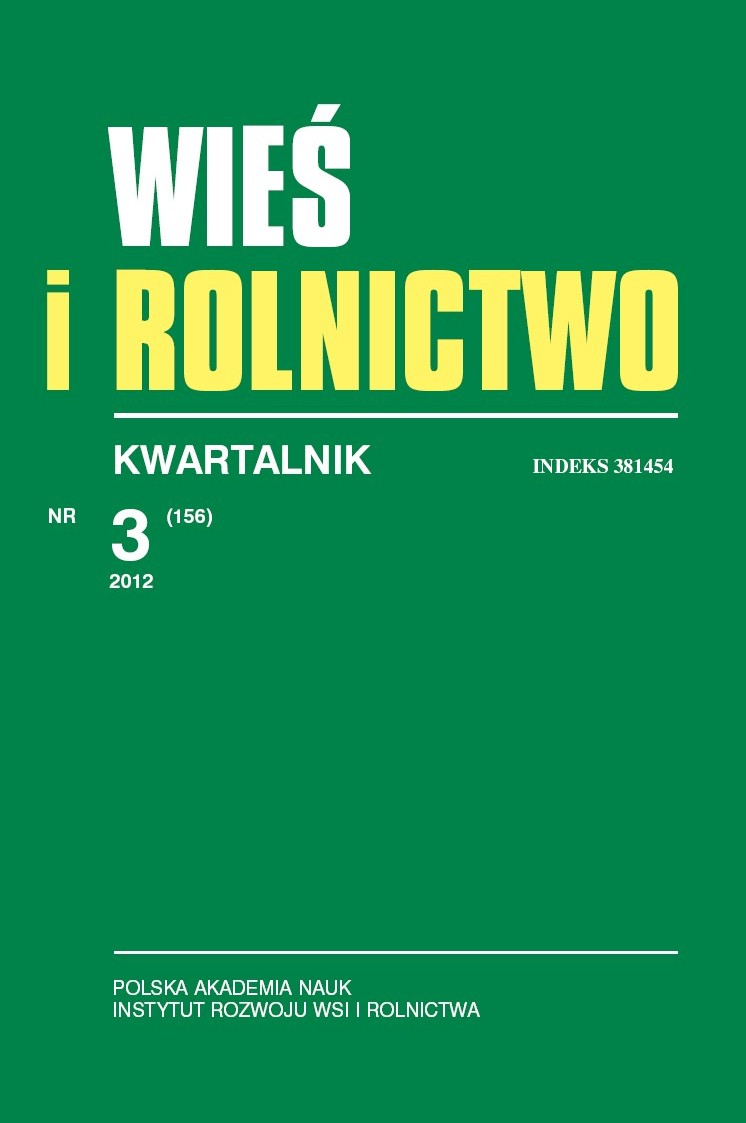The role of Agricultural Property Agency’s companies in the stimulation of biological progress
DOI:
https://doi.org/10.53098/wir.2012.3.156/13Keywords:
biological progress, stimulation of biological progress, plant breeding, animal breeding, seed production, plant and animal breeding companies of the Agricultural Property AgencyAbstract
The paper describes the restructuring of plant and animal breeding companies in the 1992-2011 period. An analysis of the activity of plant and animal breeding companies was conducted and their significance for the stimulation of biological progress in agriculture was determined. Over the period of 20 years of operation of the Agricultural Property Agency (ANR) - formerly the Agricultural Property Agency of the State Treasury, thorough organisational changes were made in the breeding companies. In the result of these changes the number of breeding companies fell from 132 to 46, and the area of land used diminished from 323 thousand hectares to 117 thousand hectares. Despite the thorough restructuring of plant breeding companies, their creative potential was preserved as evidenced by the unchanged pace of submission of new stocks for registration research. The last 4 years saw the stabilisation of the share of varieties provided by ANR companies in the domestic reproduction of agricultural seeds. In the ANR animal breeding companies important species of farm animals are being preserved: cattle, horses, pigs and sheep. Especially dairy cattle and horses represent the most valuable genetic material in the country. In 2011, cows from ANR companies constituted only 3.9% of cows under utility control in the country. However, nearly a half of the breeding progress is attributable to this relatively small population. Since 1993, productivity progress in the whole assessed population reached 3,200 kg of milk, while in ANR companies it reached 5,098 kg and was thus higher by 1,898 kg of milk. Mothers of bulls, which are kept by the Agency’s companies account for 62.2% of all mothers of bulls forming part of Poland’s dairy cattle herds. In the 2011/3 season, 64 Holstein-Friesian breeders were allowed for insemination, 25 of which, i.e. 39%, were bred by the Agency’s companies.References
Andrzejczak B., Helta M., 2011: Hodowla i nasiennictwo roślin rolniczych i ogrodniczych w spółkach ANR. „Hodowla Roślin i Nasiennictwo” 3 i 4.
Duczmal K.W., 2005: Polski rynek nasienny. „Hodowla Roślin i Nasiennictwo” 2.
Jasiorowski T., 2011: Hodowla trzody chlewnej w spółkach ANR. „Przegląd Hodowlany” 8: 94–11.
Jasiorowski T., Oprządek A., 2011: Hodowla bydła mlecznego w spółkach ANR. „Przegląd Hodowlany” 8: 3–9.
Marciniak K., 2008: Stan polskiej hodowli roślin w roku 2008. „Roczniki Nauk Rolniczych” G, 95. DOI: https://doi.org/10.22630/RNR.2008.95.1.19
Nalborczyk E., 1997: Postęp biologiczny a rozwój rolnictwa w końcu XX i początkach XXI stulecia. Agricola 33 – suplement. Wydawnictwo SGGW, Warszawa.
Niżnikowski R., Oprządek A., Strzelec E., Popielarczyk D., Głowacz K., Kuczyńska B., 2010: Effect of crossbreeding of Polish Merino ewes with Rams of German Muton Merino on growth rate and slaughter value of their offspring. „Ann. Warsaw Univ. Life Sci. – SGGW, Anim. Sci.” 47: 101–117.
Oprządek A., 2011: Hodowla owiec w spółkach ANR. „Przegląd Hodowlany” 8: 11–13.
Piechowska T., Jagusiak W., 2012: Hodowla bydła w Polsce w ostatnim 20-leciu i jej perspektywy. XX Szkoła Zimowa Hodowców Bydła „Perspektywy produkcji mleka i wołowiny w Polsce i na świecie”, Zakopane: 33–42.
Runowski H., 1997: Postęp biologiczny w rolnictwie. Wydawnictwo SGGW, Warszawa.
Stojanowska A., Wachel M., 2011: Hodowla koni w spółkach ANR. „Przegląd Hodowlany” 8: 13–19.
Świtoński M., Maleszy S., 2012: Postęp biologiczny w rolnictwie w erze genomiki i modyfikacji genetycznych. „Nauka” 1: 25–35.
Downloads
Article file downloads
Pages
How to Cite
Issue
Section
License
Copyright (c) 2012 Wieś i Rolnictwo

This work is licensed under a Creative Commons Attribution 4.0 International License.










